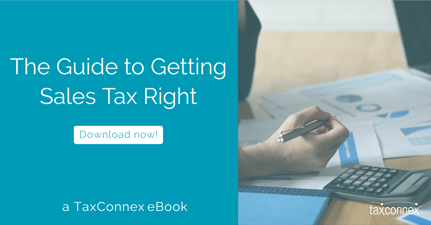Sales tax is more complicated than ever, especially in a post-Wayfair world. And what’s worse is that everyone who says they’re simplifying sales tax is still leaving the hardest parts – and the liability – up to you. Don’t let sales tax compliance overwhelm you. Make the right decisions for your business so you can best manage compliance in a way that doesn’t overburden your finance team or put your business at risk of penalties and fees.
.jpg?width=287&name=pexels-fauxels-3184298%20(1).jpg) Doing some quick research on the internet, you can find information on sales tax nexus, voluntary disclosures, sales tax calculation tools and more. Some companies attempt to make sales tax simple and are really focused on “pushing product”, but often they aren’t really giving you everything you need to simplify sales tax.
Doing some quick research on the internet, you can find information on sales tax nexus, voluntary disclosures, sales tax calculation tools and more. Some companies attempt to make sales tax simple and are really focused on “pushing product”, but often they aren’t really giving you everything you need to simplify sales tax.
Sales tax is far from simple, but it doesn’t have to be overwhelming. This blog will help explain one part of the sales tax compliance puzzle: your filing process.
Once you’ve determined your requirement to collect and remit sales tax, you’ve set-up a process to charge sales tax, and you have registered with each required state, you need to consider how you will manage the return filing process. Below are 5 key pieces of your sales tax filing process that need to be managed accurately.
- Tax Data Reports - In a perfect world, all your sales tax calculations will be managed in one system and you will be able to produce a single report each month that provides details with all of your sales and use tax liabilities. However, the reality is that businesses grow, they acquire other businesses, they change accounting systems, they launch new e-commerce platforms - all resulting in different sales tax processes. Be sure you have a process to gather the applicable data each month and reconcile this data to your general ledger before you start the filing process.
- Tax Calendar - It’s critical to maintain an accurate tax calendar that reflects where your business is registered for sales tax purposes, the filing frequency of each return, the e-file login credentials, and other state-specific information. This tax calendar is not a static item, it will need to be maintained and updated over time as your filing frequencies may change or you may register in additional state or local jurisdictions.
- Online vs. Paper Returns – You should have a process to prepare and file both online returns and paper returns. Most every state will be an online filing with an electronic payment. Local jurisdictions often require paper returns with a check. Be sure to understand any IT restrictions that may prevent you from accessing the states’ website and also recognize your internal deadlines to process checks.
- Notice Management – Jurisdictions enjoy sending you mail. Some of this mail may be informational but still critical. For example, you may receive a notice of a change in filing frequency from quarterly to monthly.
If you miss this change, and skip two monthly returns, you will be penalized. Additionally, you may receive a deficiency notice that requires you to correct an issue. These deficiency notices generally have very tight time frames by which you must respond – 5 days, 10 days, etc. - Controls – If you are a public company or have various financial covenants, you will have to thoroughly document your process including the various controls in place that ensure the process is executed effectively each month. These controls will also have to be reviewed periodically and tested to ensure proper operation.
Just these fives tasks can seem like a lot, and honestly, there are a lot of moving pieces that need to be managed. And even when you think you have this under control, remember these are the only steps in your sales tax filing process. Your sales tax compliance process also needs to include monitoring your evolving nexus footprint, understanding the taxability of your products/services in each jurisdiction where you have nexus, choosing a way to calculate charge the correct sales tax rate to your customers and keeping up with registrations for states where you have an obligation.
Sales tax compliance can seem overwhelming if you don’t have experience in this area and in a post-Wayfair world, it just keeps getting more confusing. Many businesses are still relying on internal resources to juggle sales tax along with their other job responsibilities, some turn to an automated solution, only to find they are still managing a lot of it by themselves, and some are risking it all and just waiting for a potential audit to catch them in their errors. Make things easier on everyone, and turn to a sales tax expert that can guide you throughout the process, or better yet, if you have your calculation solution figured out already, let TaxConnex do the rest!
Get in touch to learn how TaxConnex sales tax outsourcing services can help remove this burden from you completely.
For more information on how to get sales tax right for your business, read our eBook – The Guide to Getting Sales Tax Right in 2021.







.png?width=1200&height=628&name=2023%20logo%20with%20SOC%20and%20clearly%20rated%20(2).png)